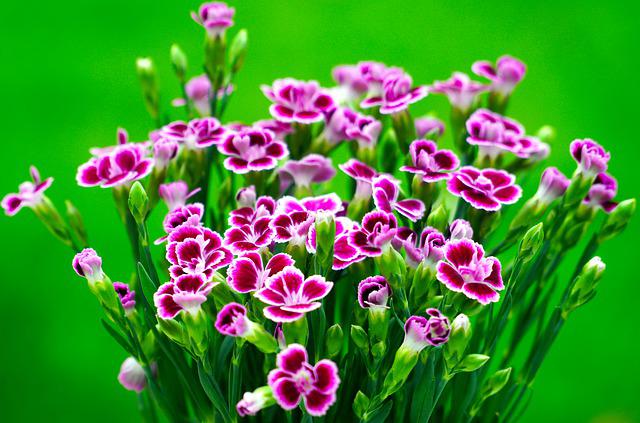Are you excited to know about how to care for dianthus? if yes, then you are on the right page. In this article I will guide you on everything about how to grow & care for dianthus or Sweet William.
Before learning on how to care for this plant, let us know little bit of interesting facts and features of this alluring flowering plant. Flowers of dianthus are known for their spicy fragrance.
Table of Contents
Introduction
Dianthus is not only a name of a flowering plant. But, it is a name for a genus that have more than 200 species of flowering plants. Botanists believe that these species are native to Europe and Asia.
However, few species are also found in Africa and North America. Species of dianthus can be perennial, biennial, as well as annuals. They are mostly herbaceous plants but few varieties are low sub-shrubs.
The factor which makes dianthus a popular flowering plant is the colour of its flowers and strong spicy fragrance. Especially the perennial pink variety has the strongest smell. They have five petals flower that ranges from white, pink, yellow to red in colour.
In the year 2012, when I was in Nainital, I spotted this flowering plant in my boarding school’s garden. I went closer to this plant and smelled the flowers. After that day it became a daily routine.
Later on, I asked the gardener for seeds and he happily gave few seeds to me so that I can grow them in my home garden. And now, here I am sharing guide with you to grow and care dianthus in your home garden.
How to grow dianthus?

Growing dianthus is not a tough job but few mistakes can kill your beautiful plant. And I completely understand the importance of plants in your heart. That’s why read the complete article to knowing growing and caring for your dianthus plant.
To grow dianthus, you will need to know about growing season, potting mix, propagation methods and transplantation.
To know about these points you don’t have to go anywhere else. I have made a simple yet effective guide for you.
Growing Season
Growing season of dianthus depends on the region where you are living. If you are living in temperate or hilly region then you can germinate seeds in spring season. But, if you are living in tropical to sub-tropical region then autumn or late summer is the best time to germinate seeds.
Generally, if temperature is the range of 15 to 21 degrees celsius then dianthus seed can germinate properly. Dianthus can grow in plant hardiness zones 2, 3, 4, 5, 6, 7, 8, 9, and 10.
Potting Mix
Dianthus loves well drained, fertile, and alkaline soil that is rich in organic matter. Soil pH can be in the range of 6 to 7.5. If you want to grow your plant successfully then prepare potting mix with:
40% normal garden soil + 20% river sand + 40% any organic compost like vermicompost. You can also add half teaspoon of bone meal and a handful of neem cake fertilizer for best response.
If your soil is sandy loam soil then you do not need to mix sand in the potting mix. Instead, you can add cocopeat in the same percentage as sand.
Selection of Pot
Dianthus do not need much bigger pot to grow. Small to medium sized pot is considered good to grow dianthus. Gardeners also loves to grow this beautiful flowering plants in hanging baskets.
However, dianthus plant loves well drained soil. That means you will need to ensure good drainage in the pot. Avoid water logging conditions by having two to four drainage holes at the bottom of the pot.
You can select earthen, cemented or plastic pots for this purpose. In a 6 inches pot, you can grow one plant for best results.
READ MORE: HANGING POT IDEAS FOR YOUR GARDEN
Propagation
You can propagate dianthus from seeds or cuttings. In this article I will guide you to grow dianthus from seeds. Fill the growing pot or germination tray with the potting mix. Leave some space at the top for watering purpose.
Purchase high quality and disease resistance seeds from online plant store or nearest plant nursery. You can either sow the seeds in line or broadcast them directly on the potting mix in the pot.
In germination tray you can sow two to three seeds in each case. Cover the seeds with a very thin layer of potting mix and apply water gently. Do not over water. Just water enough to moist the seeds.
Place the pot or germination tray in semi shade. Keep checking the pot regularly. If the top layer of soil seems drying up then apply water just to moisten the soil.
Within 7 days you will notice seedlings coming out of the seeds. After 15 to 20 days when your seedlings will reach 4 to 5 true leaved stage then you can start transplanting them.
Transplantation
If you have purchased seedlings from the plant nursery. Or you have germinated seeds in you can garden, you can easily follow this step to transplant your plant in the new pot.
Fill the selected pot with the same prepared potting mix. And leave one to two inch space at the top for watering and fertilizers application. Dig a hole in the centre and carefully transplant your plant to the new pot.
Do not disturb or damage the roots of the plant while transplanting. Apply water gently and take care not to over water in your pot while transplanting. Keep the pot in semi shade where it can receive filtered sunlight for 5 to 6 days.
Once your plant gets well established in the new pot and starts looking healthy then you can shift it under direct sunlight.
How To Care For Dianthus?

Once you have grown your plant, the next important step is to care for them. Caring for your plant will make your plant healthy and in return it will gift you beautiful flowers.
There are few important points such as sunlight and fertilizers requirement of the plant, watering, and pest and disease management. Caring about these points will not only make your plants happy but it will help you to connect with them too.
Sunlight Requirement
To care for dianthus you need to place your pot in an area that receive 5 to 6 hours of direct sunlight everyday. Dianthus loves bright sunlight to grow and prosper. Good amount of sunlight helps in vegetative growth of the plant.
It also saves the plant from fungal diseases.
Watering
Dianthus can get affected from root rot or stem rot disease. But it doesn’t mean that it does not love moist soil. This flowering plant loves moist and well drained soil. That means you should not over water in your pot.
Also make sure that after watering, the water should come out of the pot after moistening soil layers. You can apply water in early mornings or in the evenings whenever the top layer of the soil becomes dry.
Fertilizers
I do not consider adding nitrogen rich or inorganic fertilizer beneficial to this plant. Excessive nitrogen can reduce blooming in the plant. But you can add organic fertilizers periodically to make this plant happy.
30 days after transplantation you can start feeding your plant. Feed with a handful of bulky organic manure like vermicompost + half teaspoon bone meal once after every 30 days.
You can start feeding your plants with banana peel fertilizers when your plant starts producing flowers. Make sure to add one teaspoon neem cake fertilizer before applying banana peel fertilizer. It will protect your plant from fungal diseases.
READ MORE: HOW TO MAKE AND USE BANANA PEEL FERTILIZER
Pest and Diseases
Most of the varieties of dianthus is pest and disease resistant. However, you can mainly kill your plants by over watering and excessive application of fertilizers.
In severe cases spider mites and aphids can attack your plant. You can easily protect your plant by spraying 3 to 4 cloves of garlic and chilli crushed in one litre of water. Spray this solution in early mornings or evenings once after every month.
This will help to save your dianthus plant from any pest or disease attack.
READ MORE: HOW TO SAVE PLANTS FROM APHID ATTACK!
If you have any doubts regarding dianthus care or on how to grow dianthus then you can comment your queries below. You can also connect with Agriculture Review on Facebook and Instagram.




How can I get grass out of my Diantha Garden
can I dig out the Diantha kill weeds then replant Dianthas
Hi John,
It is the perfect month for transplantation of dianthus, hence you can take them out carefully and replant them after removing weeds. But if you have large population of dianthus, then remove weeds manually and apply paddy straw mulch around dianthus to limit the growth of weeds.
I hope this will help!
மிகவும் நன்றாக இருக்கிறது.நல்ல புரியும்படி கூறியுள்ளிர்.மிக்க நன்றி.
Thanks!